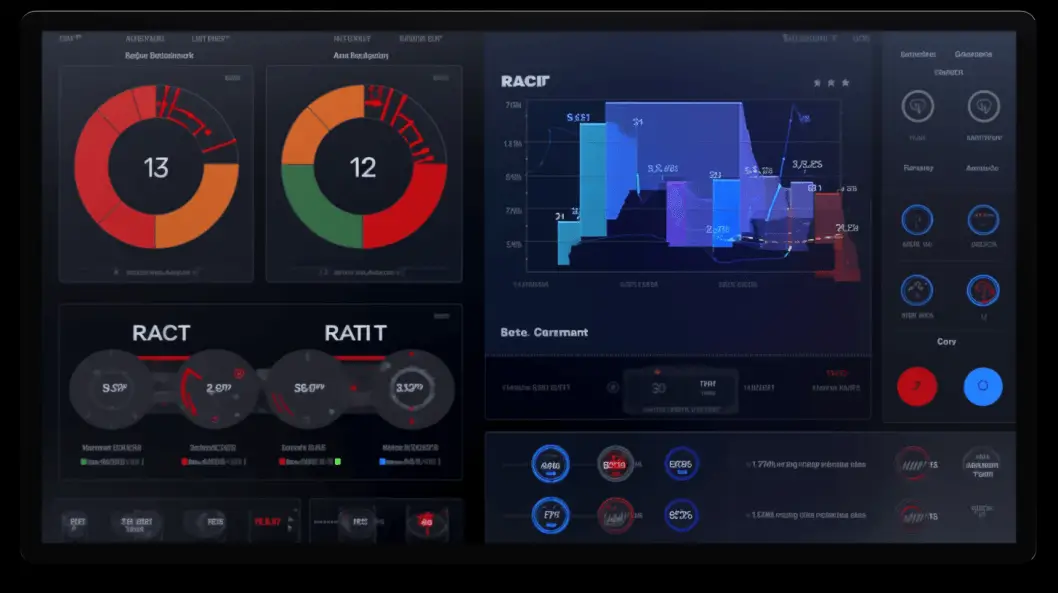In the dynamic landscape of industries where risk and uncertainty lurk around every corner, robust and comprehensive risk assessment tools such as the RACT (Risk Assessment Categorization Tool) have become integral for effective management.
The daunting intricacies and unpredictable challenges accompanying decisions demand a reliable method to evaluate, prioritize, and manage potential risks. In this context, RACT equips organizations with a structured, systematic approach to identifying and evaluating these risks.
This article delves into an in-depth understanding of this crucial tool, presenting a well-rounded exploration of its components, real-world applications, advantages, limitations, and potential future developments.
Understanding RACT
Understanding RACT (Risk Assessment Categorization Tool)
The Risk Assessment Categorization Tool, also known as RACT, is an instrumental tool tailored to assist in risk management activities across numerous industries.
Originating from the need to identify, assess, monitor and control potential risks systematically, it has become a core component of successful risk management strategies in numerous spheres.
Why The RACT Is Important
The significance of the RACT cannot be overstated. It offers a structured method to pinpoint potential risks, categorize them based on severity and likelihood, and lays out a detailed plan for mitigating them.
Its main goal is to maintain and enhance effective risk management while minimizing the impact of potential risks on an organization’s operations and objectives.
The Mechanism Of The Risk Assessment Categorization Tool
RACT provides a framework to identify, assess, and categorize risk. Firstly, the tool prompts for identifying potential risks according to an organisation’s various operations, functions, and processes.
Once the potential risks are identified, the tool facilitates the assessment of these risks. This can be based on factors such as the potential impact of the risk, the probability of its occurrence, the extent of its potential damage and the resources required for its management.
Having assessed the risks, RACT then categorizes these risks systematically. Categories could be according to severity (mild, moderate, severe), impact (low, medium, high) or likelihood (unlikely, possible, probable).
The categorization is instrumental in helping prioritize resources and efforts towards managing these risks effectively. This systematic approach allows for efficient resource allocation and assists organizations in risk mitigation.
The Various Uses Of RACT Across Different Industries
RACT has a widespread application across multiple industries. This is primarily due to its capacity to handle any risk irrespective of context.
Whether it’s employed in healthcare for patient safety and quality improvement, utilized in project management to anticipate project-related risks, in IT for cybersecurity threats, or manufacturing for operational, safety and quality risks.
The versatility of RACT remains the same: it systematically identifies, assesses, categorizes, and aids in the control of different types of risks.
Introduction to RACT
Grasping the concept of RACT (Risk Assessment Categorization Tool) goes beyond simply understanding its functioning. It involves an appreciation for its extensive usage and importance across various sectors.
It’s essential to acknowledge the pivotal role of RACT in forecasting risk identification, executing a systematic risk assessment, categorization, and tactical risk control.
This comprehensive approach enables precision in resource allocation, fosters informed decision-making and instil stronger and all-encompassing organisational risk management strategies.

Components of RACT
RACT and Hazard Identification
When analyzing the RACT Risk Assessment Categorization Tool, hazard identification forms an important part. It encapsulates the process of revealing potential risks in any situation.
These risks may vary from common threats to unforeseen ones that previous models did not consider. The RACT facilitates users to identify such hazards accurately, enabling them to make knowledgeable decisions towards risk assessment and risk reduction measures.
Vulnerability Assessment in RACT
A vulnerability assessment in RACT involves examining the weak spots within an entity or process that could make it susceptible to identified hazards or risks.
This component of RACT is crucial to understanding the systems’ inherent weaknesses that potential hazards could exploit.
Vulnerability assessment in RACT can highlight areas that need strengthening to withstand or mitigate identified risks, thus contributing significantly to the risk management process.
Impact Analysis in RACT
Following hazard identification and vulnerability assessment, RACT’s impact analysis comes into play. This component evaluates the potential consequences of a hazard materializing and exploiting identified vulnerabilities.
The resulting impact is predicted based on various factors, such as the vulnerability scale and the hazard’s potency. The impact analysis in RACT offers an estimation of the severity of the consequences of a risk event, an essential resource in prioritizing risks and allocating resources efficiently for risk management.
Risk Estimation in RACT
Risk estimation is the final key component in RACT. This phase involves quantifying the risk based on the data gathered during the previous stages of hazard identification, vulnerability assessment, and impact analysis.
The goal is to generate a numerical or categorical value that represents the severity and likelihood of a risk, allowing decision-makers to prioritize risks and design appropriate mitigation strategies.
Risk estimation in RACT provides a tangible metric for understanding the scale of potential risks in a given scenario.
Introduction to RACT Risk Assessment Categorization Tool
Focusing on comprehensive risk assessment, the RACT Risk Assessment Categorization Tool systematically identifies potential hazards. It assesses vulnerabilities, analyzes possible impacts and estimates risks, providing an in-depth evaluation of risk levels.
Each component plays an important role in this process, making RACT a thorough and precise tool for the task. RACT’s primary goal is identifying risks and supporting the development of effective risk management strategies, making it invaluable for industry professionals in various sectors.

RACT in Practice
Using RACT (Risk Assessment Categorization Tool) Effectively
Practically, RACT is a structured method that identifies and categorizes risks threatening an organisation’s aspirations, projects or operations.
It serves as a proactive tool, establishing a strong basis for risk identification, analysis and treatment, which helps to facilitate rational decision-making. By classifying risks based on diverse factors such as severity, probability, and impact, RACT optimizes risk mitigation by assisting in prioritising actions against identified risks.
Case Studies On the Use Of RACT
Case studies prove to be an effective way of illustrating the practical application of RACT. For instance, RACT has been effectively implemented in the healthcare setting to assess and prioritize potential patient safety risks.
Categorizing risks based on severity and frequency, healthcare professionals can allocate resources effectively and establish proactive measures to prevent adverse outcomes.
In the financial sector, RACT is employed to analyze the potential risks associated with different financial activities holistically.
This detailed analysis can significantly aid decision-making processes, making risk management more efficient and effective.
Practical Guidelines For Using RACT
Organizations must first identify the potential risks that could impact their operations or objectives to use RACT effectively. This step usually includes data collection from multiple sources, brainstorming sessions, and expert assessments.
Once potential risks are identified, they should be categorized based on various factors such as their frequency, significance, and probable impact. The categorized risks are then given a numerical score. The higher the score, the higher the priority of the risk.
Implementation would then depend on developing strategies to manage the identified risks, prioritising the ones with higher scores. The main aim here is to decrease their likelihood, impact, or in some cases, even both.
It is important to note that the results should be regularly reviewed, updated, and communicated across the organization.
Any changes in the internal or external environment can introduce new risks or change the nature of the existing ones, requiring a continual update of the RACT.
Significance of RACT for Effective Risk Management
Implementing RACT (Risk Assessment Categorization Tool) in risk management allows organizations to handle, mitigate and govern their risks efficiently. This tool delivers a systematic and steadfast procedure for risk prioritization, assisting in the effective allocation of resources.
Not to mention, RACT’s ability to offer insights into prospective outcomes and their probability gives organizations the power to make informed decisions and frame strategic risk management plans.

Advantages and Limitations of RACT
Expanding on the Benefits of RACT: A Comprehensive Tool for Risk Assessment and Categorization
RACT shines in many industrial applications as a holistic tool designed to evaluate and govern potential risks. Its primary strength lies in its offering: a well-structured, systematic approach to risk assessment. By bucketing potential risks, organizations have the opportunity to prioritize and confront the most threatening risks head-on.
Efficiency and effectiveness are two key attributes where RACT excels in risk management. The tool paints a clear picture of potential risks, judging their probable impacts, frequency of occurrence, and measures in place to curtail them.
This comprehensive view enables seamless communication and understanding of risk factors throughout the organization, guaranteeing everyone’s awareness of the risks and the actions implemented for their management.
The versatility and adaptability of RACT cannot be overstated. Its relevance spans different industrial landscapes and numerous operational contexts.
From small-scale business ventures to multinational corporations, the tool stands out for its ability to pinpoint potential risks and suggest practical measures for their mitigation.
Understanding the Constraints of RACT: The Risk Assessment Categorization Tool
Just like any other tool, RACT comes with its potential limitations. The evident subjectivity in risk categorization may lead to inconsistencies and inaccuracies, as different individuals could interpret risk levels differently. To avoid this, it is imperative to establish clear guidelines and standards.
Additionally, implementing RACT might be time-consuming, particularly in larger organizations with intricate risk profiles. The processes of identifying, rating, and addressing risks could potentially require substantial resources.
It’s also crucial to note that while RACT’s flexible framework can be utilized across different industries, it is not a universal solution. Its effectiveness can greatly differ based on each industry or organisation’s distinctive needs and features.
To cap it off, the accuracy and accessibility of data greatly influence the effectiveness of RACT. Using incorrect data might cause misinterpretations of the probability and impacts of risks.
Foreseeing unprecedented or unidentified risks can be a real challenge, a limitation RACT shares with other risk assessment methods.
In conclusion, while RACT offers a systematic and structured risk management approach, the tool’s practical implementation should consider these potential limitations for a successful risk management effort.

Future Trends and Developments in RACT
The Contemporary Application of the RACT
The Risk Assessment Categorization Tool, or RACT, has made its way into the mainstream across diverse industries to thoroughly examine work procedures, spot possible hazards, assess associated risks, and apply fitting control measures.
This methodology enables industries to foresee potential risks and strategically take action to minimize them in their early stages. It favours a proactive stance over a reactive one, tackling risks before they can culminate in accidents or incidents.
Trends and Future Developments in RACT
With advancements in technology, RACT has increasingly reached new heights of functionality and reliability. One of the major trends affecting RACT is the rise of automation and digitalization.
Companies are increasingly incorporating automated systems in their risk assessment processes to streamline reporting and auditing, improve accuracy, and reduce the time and effort needed to carry out assessments.
Artificial Intelligence (AI) is another technology that holds immense potential for the future of RACT, as it can be used to make predictive analytics even more accurate.
AI-powered RACT can analyze historical data to identify patterns and predict future risks otherwise difficult for humans to foresee. This allows for more proactive risk management.
The advancement of machine learning also plays a significant role in enhancing RACT’s functionality. Machine learning algorithms can help study patterns in unstructured data to provide valuable insights regarding potential risks and hazards.
Integration of IoT with RACT
Internet of Things (IoT) technology also provides exciting possibilities for RACT. Integrating internet-enabled sensors and devices in the workplace can provide real-time data regarding parameters such as temperature, pressure, and vibration levels.
This data can be utilized by RACT to identify potential risks as they emerge, allowing companies to react quickly and prevent incidents.
Regulatory Changes and RACT
Future developments in RACT will also likely be influenced by changes in regulation and legislation related to risk management. As governments and regulatory bodies strive to create safer workplaces, regulations might become stricter, making standardized, systematic, and comprehensive risk assessments like RACT more vital than ever.
Cloud-based RACT Technologies
The shift towards cloud-based technologies is another significant development that could influence the future of RACT.
Cloud-based RACT solutions would allow data to be stored, accessed, and analyzed from anywhere, enhancing risk assessment processes‘ overall efficiency and flexibility.
Conclusion
In summary, as we advance technologically, the confluence of automation, AI, ML, IoT, and cloud technologies is set to revolutionize RACT and offer more comprehensive, efficient, and precise risk assessment capabilities.
These advancements, coupled with stricter regulatory requirements, will likely make RACT an invaluable tool in the world of risk management.

As we embrace the future, the RACT is anticipated to evolve, aligning with advanced technologies and applications in risk management. The upcoming trends, enhancements, and possibilities open the potential for how this risk assessment tool might be further improved and utilized.
As it stands, RACT remains an essential, versatile tool in an organization’s arsenal, striking a balance between proactive risk management and nurturing growth opportunities.
As technology and risk landscapes evolve, so will the tool, paving the path for enhanced efficiency, precision, and innovative applications.

Chris Ekai is a Risk Management expert with over 10 years of experience in the field. He has a Master’s(MSc) degree in Risk Management from University of Portsmouth and is a CPA and Finance professional. He currently works as a Content Manager at Risk Publishing, writing about Enterprise Risk Management, Business Continuity Management and Project Management.

